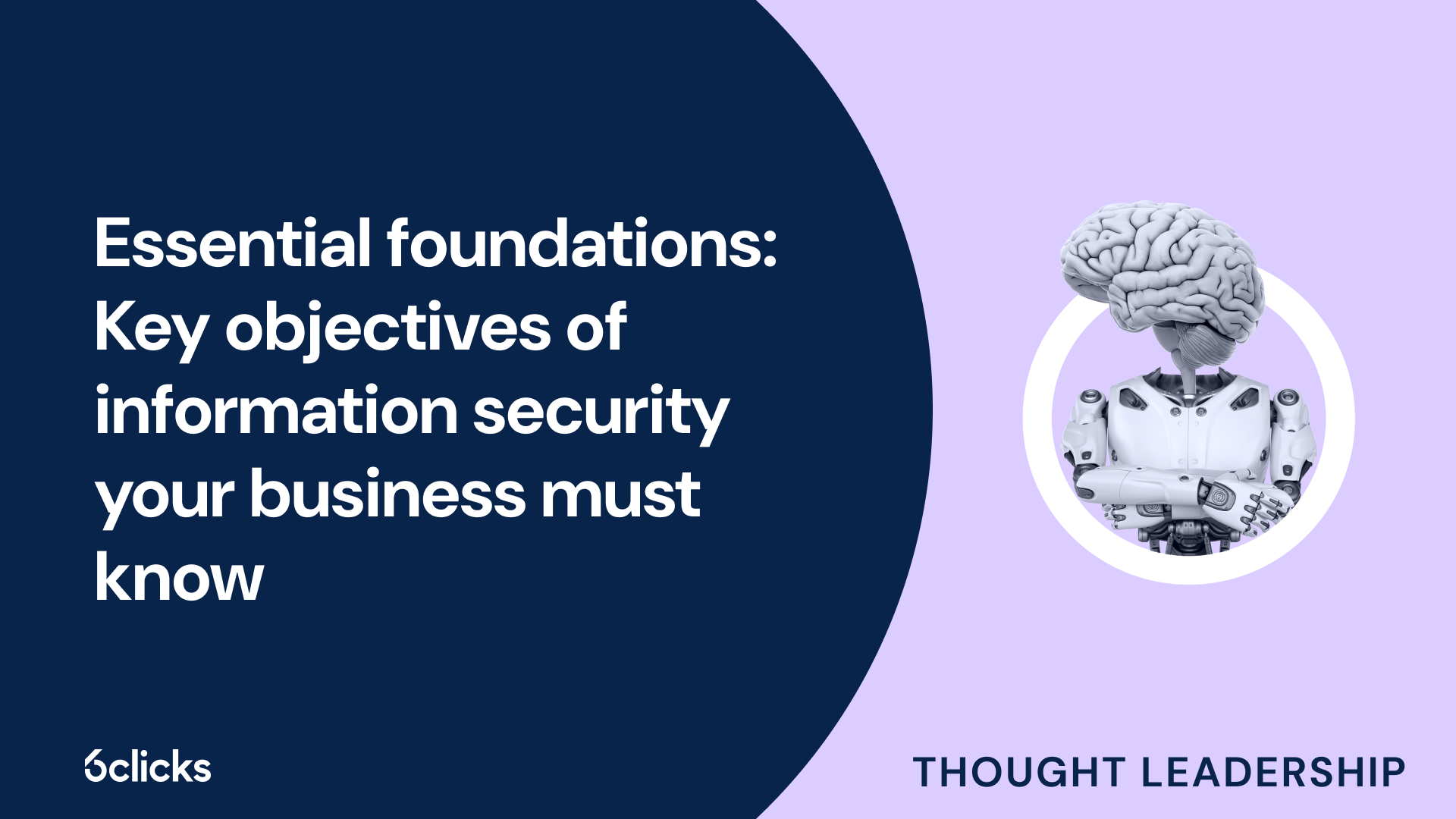
Information security isn’t just about firewalls and access controls anymore. For modern enterprises, it’s about enabling growth, protecting digital trust, and operationalizing resilience at every layer of the business. The real challenge is striking a balance between proactive risk management, regulatory alignment, and ensuring the protection of sensitive data, all without slowing down innovation. Today we will break down the core pillars of information security and explore how advanced strategies, including AI and automation, are driving more effective, future-ready programs.
Understanding the importance of information security
At its core, the purpose of information security is to ensure that an organization’s data is protected against unauthorized access, alteration, and disruption. It aims to uphold the confidentiality, integrity, and availability of information throughout its lifecycle.
Today, information security is more than just a technical function, but a strategic enabler. It brings together the right combination of people, processes, and technologies, encompassing every aspect of digital operations, from customer engagement and service delivery to compliance and innovation. When executed well, it creates a resilient foundation that supports long-term growth.
A robust information security posture offers much more than just protection against cyberattacks. It:
-
Strengthens stakeholder trust by demonstrating your commitment to data protection
-
Minimizes financial and operational risks through effective controls
-
Ensures business continuity even in the face of cyber incidents
-
Supports compliance with growing regulatory and industry-specific requirements
-
Increases competitive advantage by securing digital transformation initiatives
Information security: Key objectives
Effective information security must start with a clear understanding of its key objectives. Often summarized through the CIA triad (confidentiality, integrity, and availability), let’s explore each of these in detail, including the controls and technologies that support them.

Protecting confidentiality
The objective of protecting confidentiality is to restrict access to information so that only authorized individuals can view or handle it. A breach in confidentiality can compromise trust, trigger regulatory violations, and result in significant financial loss.
Most organizations apply structured classifications to confidential data to ensure the right level of protection is applied. Two commonly used classifications are:
-
Sensitive information – Data that, if exposed, could cause harm to individuals or the business. This includes PII (personally identifiable information), PHI (protected health information), financial records, credentials, internal communications, and intellectual property.
-
Classified information – A stricter designation often used in government, defense, or regulated sectors. This refers to information categorized by security level (e.g., Protected, Secret, Top Secret) and governed by formal access protocols due to national security implications.
Key components and controls include:

-
Access control: Enforcing least privilege access and role-based permissions
-
Authentication mechanisms: Strong password policies and multi-factor authentication (MFA)
-
Encryption: Protecting data at rest and in transit using strong cryptographic standards
-
Data classification and labeling: Identifying and tagging data according to sensitivity and required handling
-
Physical safeguards: Restricting physical access to systems, storage, and facilities
-
Security awareness training: Educating employees on safe data handling and identifying potential confidentiality risks
These measures create the baseline needed to protect sensitive and classified information across your organization.
Ensuring data integrity
Integrity guarantees that data remains accurate, consistent, and trustworthy throughout its lifecycle. Organizations often classify integrity-critical data based on the impact of potential alteration. For example, transactional data such as payment logs and audit trails directly affects reporting, tax, and compliance outcomes.
Whether data is at rest, in transit, or being processed, any unauthorized alteration—accidental or malicious—can compromise operational decisions, regulatory compliance, and even safety. Any unauthorized changes must be detectable and reversible.
Here are measures for ensuring data integrity:
-
Audit trails and logging: Track who accessed or modified data and when, to support forensic analysis and accountability
-
Input validation: Enforce rules that ensure data is entered correctly and within expected formats
-
Checksums and hash functions: Detect unauthorized changes during transmission or storage
-
Version control: Maintain historical records of data or document changes to enable rollback if needed
Preserving data integrity is especially crucial in environments with high volumes of automated processing, where a small error can rapidly propagate across systems.
Maintaining availability
Lastly, availability ensures that systems, services, and data are accessible when needed; without delay, disruption, or degradation. It’s about guaranteeing uptime, maintaining service levels, and ensuring continuity even in the face of hardware failure, cyberattacks, or natural disasters.
Keeping systems and data accessible requires a combination of components and controls such as:
-
Redundancy: Duplicate hardware, failover servers, and high-availability configurations to prevent single points of failure
-
Regular data backups: Routine and automated backups stored in geographically separated locations
-
Disaster recovery planning: Documented, tested plans for system restoration and continuity of operations
-
System monitoring: Real-time tracking of performance, uptime, and resource utilization
Maintaining availability is essential not just for operational continuity, but for delivering reliable services and meeting stakeholder expectations across any industry.
Best practices in information security
Establishing strong controls is just the beginning. Sustaining information security requires continuous improvement, strategic alignment, and the smart use of tools that reduce manual effort and human error.
Proactive security through risk management
Risk management is the backbone of any mature information security program. Effective information security isn’t just about responding to incidents but about anticipating and mitigating risk before it materializes. A proactive risk management approach allows organizations to identify vulnerabilities, assess potential impacts, and prioritize resources based on concrete, measurable insights.
While traditional risk registers and periodic assessments are still important, leading organizations are evolving their approach by adopting more dynamic, data-driven strategies such as:
-
Automated risk identification: Using AI and machine learning to detect emerging threats based on behavioral patterns, threat intelligence feeds, and environmental signals
-
Continuous control monitoring: Leveraging automation to monitor the effectiveness of controls in real time, reducing the need for point-in-time audits
-
Centralized risk intelligence: Integrating risk data across business units, subsidiaries, and third parties into a single source of truth for faster, more informed decision-making
-
Performing regular risk assessments and threat modeling: Continuously evaluating risks and potential attack paths to understand how threats could exploit vulnerabilities and disrupt operations
-
Real-time reporting and dashboards: Providing leadership with up-to-date visibility into risk posture, treatment status, and compliance gaps
Modern GRC platforms like 6clicks have advanced capabilities to help you shift from reactive processes to proactive risk governance. With 6clicks, you can automatically raise risks and issues directly from assessments and generate treatment plans using AI, use Continuous Control Monitoring to conduct automated control tests and get real-time validation of your security posture, and easily track control performance, high-priority issues, and other key metrics using customizable dashboards and one-click reports. By leveraging AI, you eliminate manual effort, improve accuracy, and accelerate response across your risk and compliance workflows.
Aligning with regulatory requirements and information security standards
Regulatory alignment is a foundational element of any robust information security program. Adhering to recognized standards not only helps ensure consistency and accountability, but also reinforces your organization’s ability to manage risk and demonstrate due diligence. Key information security frameworks that should be part of your compliance strategy include:
-
ISO/IEC 27001 – A globally recognized standard for implementing information security management systems (ISMS). Applicable to any organization, it focuses on risk-based controls, governance, and continuous improvement.
-
NIST Cybersecurity Framework (CSF) – Another widely adopted standard for cybersecurity risk management, the NIST CSF is a voluntary framework that centers around six functions: Govern, Identify, Protect, Detect, Respond, and Recover.
-
SOC 2 – Typically used by SaaS and cloud service providers, SOC 2 evaluates an organization’s controls against trust principles including security, availability, processing integrity, confidentiality, and privacy.
-
Health Insurance Portability and Accountability Act (HIPAA) – A U.S. regulation that requires healthcare providers, insurers, and other entities handling patient data to implement administrative, physical, and technical safeguards to protect electronic protected health information (ePHI).
-
Information Security Manual (ISM) – Published by the Australian Signals Directorate (ASD), ISM outlines cybersecurity controls mandatory for Australian government agencies, defense contractors, and critical infrastructure operators.
-
UAE Information Assurance (IA) Regulation – This regulation mandates baseline security controls for government entities and critical infrastructure sectors in the UAE, focusing on national data protection and cyber resilience.

6clicks can help you easily align with information security standards and regulatory requirements through Hailey AI. Automate framework mapping and instantly compare authority documents at the requirement level, then identify gaps and assess your compliance within seconds through automated control mapping. With 6clicks, you can simplify compliance across multiple frameworks, eliminate manual inefficiencies, and streamline audit readiness.
Developing an information security policy
An information security policy serves as a governance instrument that defines your organization's commitment to managing information risk. It aligns security objectives with business strategy, sets expectations for operational behavior, and establishes the foundation for a defensible and auditable security program.

A well-structured policy should:
-
Define scope and objectives aligned with organizational risk appetite, regulatory requirements, and business priorities
-
Establish governance and ownership, including roles and responsibilities across executive leadership, IT, compliance, and operational teams
-
Document control requirements related to access, data classification, encryption, system configuration, and acceptable use
-
Outline incident response and escalation protocols, including internal communication paths and regulatory reporting obligations
-
Specify monitoring, audit, and enforcement mechanisms to ensure accountability and continuous improvement
Beyond internal governance, your information security policy provides assurance to auditors, regulators, and partners that your organization is actively managing information security in a structured and accountable way.
Wrapping up: Building a secure future for your business
Strong information security doesn’t happen by accident. It requires clearly defined objectives, alignment with regulatory and industry standards, and a proactive approach to identifying and managing risk. By focusing on the core principles of confidentiality, integrity, and availability—and supporting them with well-governed policies, effective controls, and continuous monitoring—organizations can build resilient, audit-ready programs that scale with business growth.
Modern challenges demand more than static policies and manual processes. Leveraging advanced tools like AI and automation allows security teams to reduce complexity, improve accuracy, and respond to risk in real time. This empowers organizations with robust information security programs that deliver assurance, enable innovation, and support long-term strategic goals.
Get started with 6clicks
Strengthen your information security program with an all-in-one, AI-powered platform that can help you manage risk, streamline compliance, and build resilience at scale:
-
Ensure robust security implementation and stay audit-ready with comprehensive control management, continuous compliance monitoring, automated evidence, and built-in analytics
-
Get free access to information security frameworks, including ISO 27001, ISM, SOC 2, and other ready-to-use content such as control sets and assessment templates via the Content Library
-
Automate compliance with AI-powered mapping and gap analysis and identify alignment across multiple standards and regulatory requirements within seconds
-
Centralize risk management, compliance, vendor management, incident management, and audit functions and data in one unified system
-
Bring next-level speed, accuracy, and efficiency to traditionally manual processes like control set creation, risk identification and remediation, and responding to assessments using AI


